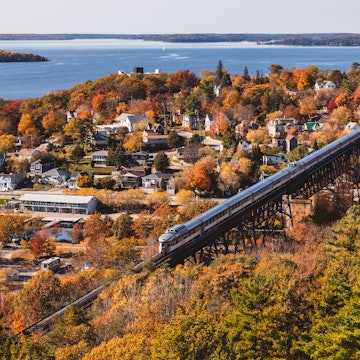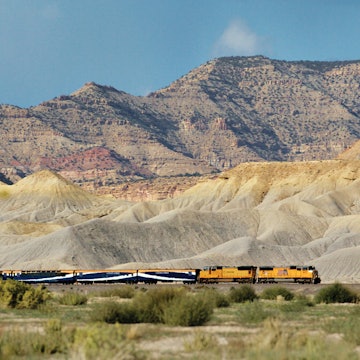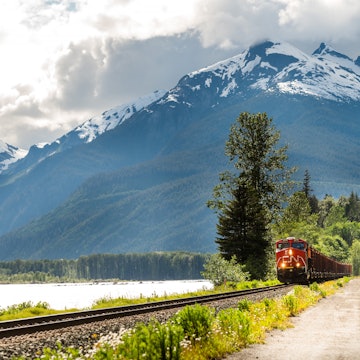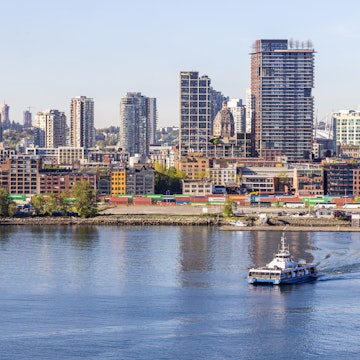
Taking the train in the USA: all you need to know



Train passengers crossing through the Rocky Mountains. Jacob Boomsma/Shutterstock
Think riding the rails is a thing of the past in the USA? Think again.
Although the USA has the largest network of roads in the world, it’s also an ideal country to see by train. You can stare out of huge picture windows for hours as snowy mountains, waving grasslands, expansive deserts and vibrant cities roll past.
Don’t expect an experience like riding the bullet trains in Japan or the expansive high-speed railway system in Spain, however. Investment in train travel in the USA has been minimal for decades. The trains in the national passenger rail service, Amtrak, are slow going and notoriously delayed – by several hours or days in extreme circumstances. And some of the train cars are pretty old-fashioned. For example, the long-distance routes that can take days to get from end to end don’t have wi-fi, and these trains depart only once a day (or even a few times a week), sometimes at odd hours, depending on where you board.
But change is coming, thanks to the 2021 infrastructure act, the biggest investment in rail since the country’s current system was created in 1971. New train routes are set to connect more cities, and the long-distance overnight trains will be upgraded for the first time in 40 years.
Though these huge updates haven’t come to fruition yet, Americans are embracing trains in a way not seen in generations. Amtrak's ridership in 2024 was its highest ever, at nearly 33 million customer trips, a 15 percent increase from the year before.
Is taking a train in the USA the most efficient way to travel? Rarely. But it’s sure to leave you with infinitely better stories than you’d have sitting at an airport.
Ready to ride? Here’s how to hop aboard the trains in the USA.

The basics of train travel in the USA
Most major American cities have their own public transit systems, which range from underground subways to aboveground light rails and buses.
To get from city to city or state to state, however, your options are fairly limited: Amtrak is the only passenger rail provider throughout the USA. Though Amtrak is technically a for-profit corporation, the US federal government is its controlling shareholder. (See below for more on a few privately owned rail lines.)
Amtrak’s trains roll across the USA from the Atlantic to the Pacific and from the Mexican border to stops in Canadian cities. More than 30 train lines cross the country on some 21,000 miles of tracks. Trains stop in 500 cities in 46 states (not Alaska, Hawaii, South Dakota or Wyoming), along with a handful of destinations in Canada. Still, huge swaths of the country – especially in the western half of the USA – are not served by Amtrak, which can make getting around by train tricky.
Book your Amtrak trip as soon as you know your travel plans
Amtrak fares vary greatly depending on the length of the journey, the fare class, the time of day, the day of travel and how far in advance you book. Prices are usually highest during holidays and peak travel seasons (summer and fall). Tickets can be booked up to 11 months in advance, and unlike flights, train prices in the USA don’t tend to fluctuate – they only go up.
In 2020, Amtrak introduced a new pricing structure. For the absolutely lowest fare, buy a ticket with the least flexibility – meaning you can’t make any changes to your trip or get a refund if you need to cancel. If you’re willing to pay a bit more, choose a ticket with more flexibility.
Reserving a sleeper room on a long-distance train far in advance can save you some serious cash. If prices happen to go down – a rarity – you can contact Amtrak’s customer service and be refunded the difference. For shorter train trips, buying tickets a few months in advance should still net you a good price.
In 2023, Amtrak introduced Night Owl fares that cost as little as $10 for departures between 7pm and 5am on Amtrak’s Northeast Corridor, which includes Washington, DC, Baltimore, Philadelphia and New York City. Prices for travel over weekends and holidays are generally more expensive, so these tickets should also be booked as far in advance as possible.
Buy Amtrak tickets online or through its app
Purchasing train tickets in the USA couldn’t be simpler. Visit amtrak.com, enter your destinations and dates, and you’re good to go. The Amtrak app also makes buying tickets easy; on the train, you just show your e-ticket in the app to the conductor.
You can also purchase tickets over the phone, through a travel agent or at the station. Occasionally, you might be able to buy a ticket once you’re on board, but this is not the norm for Amtrak. (You’ll pay the highest price, and if the train is full, you run the risk of getting kicked off at the next stop.)
Amtrak’s USA Rail Pass might make your trip cheaper
Long-distance rides can be expensive if you book last minute, so buying a USA Rail Pass might make the math work out better. The USA Rail Pass allows riders to go on 10 Amtrak segments within a 30-day period for $499. Note that a segment isn’t the same as a one-way trip; a segment ends when you get off the train or change trains. Once you purchase the pass, you must use it within 120 days (about four months). The clock starts after the first segment, and you have 30 days to take the other nine segments.
The catch? With the USA Rail Pass, you must travel in coach. Business class and private sleeper rooms are not an option unless you pay for them on top of the pass at the going rate.
Check for discounts and promotions
Amtrak extends a variety of discounts. Older adults, veterans, military personnel and their families, and Rail Passengers Association members get 10 percent off, while students get 15 percent off. Children under age 2 ride for free, and tickets for kids between 2 and 12 are half off. Passengers with disabilities, groups and government employees are eligible for discounts as well.
In addition to these regular discounts, Amtrak runs limited-time promotions. Sometimes, these sales apply to specific routes, while other times, they apply to certain seasons or times of day.

Amtrak’s train routes crisscross the country, but they don’t go to every state
When visiting many European countries, you probably wouldn’t even consider renting a car because train travel is so ubiquitous. But in the US, it really depends on where you’re going. If you’re in New England or the Mid-Atlantic, you can probably get away with traveling from city to city on Amtrak. But elsewhere, since the country is huge, you may end up needing to fly between destinations, rather than drive.
One catch: many Amtrak stations aren’t located near major airports, so if you’re hoping to fly in and then hop on a train, you might need to jump through some logistical hoops. That said, in metropolitan areas, Amtrak stations usually double as transit hubs, so you may be able to easily connect to public buses, subways and light rails.
Many of Amtrak's routes have beautifully evocative names, such as the Coast Starlight (Seattle to Los Angeles), Sunset Limited (Los Angeles to New Orleans, with an extension to Mobile, AL, set to reopen in 2025) and Silver Meteor (New York City to Miami). The California Zephyr (Emeryville to Chicago) is one of the most beloved and scenic rides, and it's also Amtrak's longest daily route: 52 hours from start to finish, if it's not delayed.
If Amtrak doesn’t go to your destination, one of its connecting Thruway buses might. Thruway buses are for train passengers only and are coordinated with a train's arrival, including when delayed.
Amtrak trains can definitely get crowded
East Coast trains are typically packed year-round. The more scenic routes, meanwhile, tend to fill up over holidays, weekends and summer months. Winter and midweek journeys are usually quieter.
Amtrak runs on public holidays, including Thanksgiving and Christmas. And while the company adds extra cars, trains still book up during these busy weeks.
Reserve a sleeper for maximum comfort
Amtrak offers four types of sleeping accommodations on its long-distance trains. Prices can be steep, but in addition to a private room, you get free meals, lounge access at large train stations and a first-class attendant.
Roomette (one or two adults): these private rooms have two seats that are pushed together at night to make a bed. A bunk above the seats can be pulled down for a second passenger to sleep. You have access to a bathroom and shower in the car (but outside your room).
Bedroom and accessible bedroom (one or two adults): bedrooms have double the amount of space as roomettes, with a sofa-style seat on one side. These private rooms have in-room sinks, toilets and showers. Accessible bedrooms are on the lower level of the train and have enough space for a wheelchair.
Bedroom suite (up to four adults): By combining two bedrooms, you can fit more friends.
Family room (two adults, two kids): This option takes up the width of the train car, with seats for four by day and two lower bunks and two upper bunks by night. You have access to a bathroom and shower in the car (but outside your room).
On some shorter regional services, you can upgrade to business class for advance seat selection, more legroom, a bigger seat and a free nonalcoholic drink. The high-speed Acela service on the Northeast Corridor also has first class, with lounge access at major stations and free food and drinks on board. Prices for business and first class can be high without many big benefits.

But the coach seats aren’t bad
Coach seats on long-distance Amtrak trains are more like living room armchairs than sardine-sized airplane seats, measuring 23 inches in width, compared with 17 inches for many airline chairs. Coach seats on shorter regional services are similar to those found on European trains.
Trains have dining options, but you can also bring your own food
If you’ve booked a sleeper room on Amtrak’s long-distance services, three meals a day in the dining car (or complimentary room service) are included. The food selection is standard American, like flat iron steak, roasted chicken, salmon and rice, and red-sauce vegan pasta.
Travelers who don’t have a private room can pay for food in the cafe car, which sells sandwiches, burgers and snacks, plus soft drinks, beer and wine. The food is overpriced and not the best, not too surprising for a captive audience.
Passengers can bring their own food and drinks on board, with some restrictions. There’s no way to heat your food (and staff aren’t allowed to handle your food or let you use the train's ovens or microwaves), and you also don’t have access to a refrigerator. You can bring alcohol on the train if you have a private room, but you can’t drink in public areas, except for what you purchase from the cafe.
Look into the train rules
Each train has its own rules and equipment for bikes. Many have designated bike racks, and you’ll need to make a reservation for your bike if you want to bring it on the train with you. Some stations allow bikes to be checked like luggage, and again, you’ll need to make a reservation for your bike.
Wi-fi is free, but it’s only available on select trains and at certain stations. It’s also a basic service that can support general web browsing, not streaming or downloading big files.
Amtrak requires riders to wear headphones while using devices that emit sound and encourages passengers to talk softly. Phone calls are not permitted. Quiet cars are available on most regional and short-distance trains.
You can bring one small personal item and two carry-on items with you on the train. On top of that, your fare includes two free checked bags.
If you’re hoping to travel with a four-legged friend, Amtrak allows passengers to bring dogs and cats that weigh up to 20 pounds. On most routes, you can bring pets on trips that last up to seven hours. You’ll need to make a reservation for your pet and pay a fee; you also must bring a pet carrier.

Amtrak is the only national passenger rail service, but...
Private train companies operate in some places. Many of these trains are stunning sightseeing routes, such as the luxury glass-domed Rocky Mountaineer, which runs between Denver and Moab, UT. Heritage lines with vintage cars also make scenic journeys, including the Grand Canyon Railway in Arizona and the Durango & Silverton Narrow Gauge Railroad in Colorado.
Other private train lines have more practical uses, such as Brightline’s service between Miami and Orlando, aimed at travelers between two major cities on a route that’s too long to drive but too short to fly.
Brightline plans to expand west to connect Las Vegas and Southern California. Dreamstar Lines also has big ambitions in the Golden State, and plans are afoot to open an overnight train between Los Angeles and San Francisco.
The best Amtrak routes and travel tips
If you’re into the idea of slow travel, Amtrak trains are perfect for you. Many routes offer absolutely breathtaking views of different parts of the country. Some can even drop you at the doorstep of a national park.
Coast Starlight
The gorgeous Coast Starlight route glides between Seattle and Los Angeles, the dramatic and ever-changing West Coast scenery unfolding right outside the window – from the snowy peaks of the Cascade Mountains to the blue waves of the Pacific Ocean. The entire journey lasts about 35 hours. If you can’t commit to the full distance, consider booking a shorter segment, like the stretch between Los Angeles and Sacramento. When riding northbound, sit on the left side of the train for optimal views of the coast.
Adirondack
The Adirondack is especially stunning in the fall, when the trees are ablaze with vivid orange, golden yellow and deep burgundy hues. But, really, it’s beautiful all year. Departing from the hustle and bustle of New York City and crossing the charming quiet of the Hudson Valley, the route hugs the New York border with Vermont, passing along the western shore of Lake Champlain, before eventually arriving in Montréal. The voyage takes 10 hours, but remember to bring your passport, since you’ll be crossing the border between the USA and Canada.
Winter Park Express
When snowflakes begin to fall in Colorado, you can ditch your car and take a scenic train ride to the ski slopes instead. The seasonal Winter Park Express ferries skiers and snowboarders from Denver through the craggy, evergreen-studded peaks of the Rocky Mountains to Winter Park Resort. The trip takes a little more than two hours. Operated by Amtrak, this route is usually offered between December and March. If your schedule allows, plan to spend a night or two at the recently renovated Crawford hotel, located inside Denver’s Union Station.

Empire Builder
The Empire Builder stretches from Chicago to either Seattle or Portland, Oregon, following in (some) of the footsteps of the expedition by Meriwether Lewis and William Clark. If you board in Chicago, you’ll traverse Wisconsin and Minnesota, then cross the Great Plains of North Dakota and Montana. Eventually, the train will climb into the Rockies and pass by Glacier National Park. Once you get to Spokane, Washington, you can choose to continue to either Seattle or Portland. The entire trip takes 46 hours, but you’ll spend all of your waking moments admiring the wild, rugged wilderness outside the train.
Sunset Limited
Riding the Sunset Limited, Amtrak’s southernmost train, is like taking a crash course in American history and geography. If you opt for the westbound route, you’ll depart from the Big Easy (aka New Orleans) before winding your way through Louisiana’s mysterious and swampy bayou. Crossing the wide expanse of Texas, the train kisses the Mexican border before heading into the high deserts of New Mexico and Arizona. The trek ends in sunny Los Angeles. The Sunset Limited is a commitment – it takes 48 hours – but you’ll get to see and experience so much of the South and Southwest that the time spent is more than worth it.
The accessibility of trains in the USA
Amtrak is taking steps to make its trains and stations more accessible. In 2024, the company spent $155 million on accessibility improvement projects.
But some disability rights groups argue that these efforts are insufficient. The National Disability Rights Network says that the company’s progress has been “uneven, spotty and, in some cases nonexistent.” Travelers with disabilities still face many obstacles when it comes to riding Amtrak, including inaccessible trains, stations, ticket counters and restrooms.
Amtrak trains have a limited number of accessible seats and rooms available. Passengers with disabilities must make a reservation for accessible travel services. This applies to people who use wheelchairs and other mobility devices, travel with service animals, are deaf or blind, and need equipment to get on and off the train.















